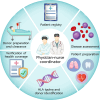Advancing the pathway to allogeneic hematopoietic stem cell transplantation through a physician-nurse coordinator system in patients with acute leukemia
- PMID: 40617838
- PMCID: PMC12228810
- DOI: 10.1038/s41598-025-10061-7
Advancing the pathway to allogeneic hematopoietic stem cell transplantation through a physician-nurse coordinator system in patients with acute leukemia
Abstract
Acute leukemia is an aggressive hematologic malignancy with a historically poor prognosis. The introduction of allogeneic hematopoietic stem cell transplantation (allo-HSCT) has substantially improved patient outcomes, offering the potential for a cure. However, prolonged preparation time for allo-HSCT can increase the risk of disease relapse or complications from consolidation chemotherapy. To address this issue, we established a physician‒nurse coordinator system to streamline and organize the preparation of patients and donors for allo-HSCT. In this single-center study, we combined prospective and historical cohorts. Adult leukemia patients (aged 18 years or older) who underwent allo-HSCT at Siriraj Hospital, Bangkok, Thailand, were enrolled. The primary aim was to compare the timing and rate of transplantation before and after the implementation of the physician‒nurse coordinator system. Between January 1, 2018, and February 1, 2024, 105 patients were enrolled. Patients diagnosed after August 1, 2021, were categorized into the physician-nurse coordinator group, resulting in 61 patients in the conventional group and 44 in the physician‒nurse coordinator group. The median (Q1, Q3) time from diagnosis to transplantation was significantly shorter in the physician‒nurse coordinator group than in the conventional group (9.0 [6.0, 14.0] months vs. 13.0 [7.5, 19.5] months; P = 0.029). Similarly, the time from diagnosis to complete preparation was significantly shorter (7.0 [5.0, 12.8] months vs. 11.0 [6.5, 17.0] months; P = 0.022). However, improvements in the transplantation rate within 6 months, relapse during transplant preparation, and post-transplantation outcomes did not reach statistical significance. Implementing a physician‒nurse coordinator system significantly reduced the time from diagnosis to allo-HSCT in acute leukemia patients. Our findings suggest that such coordinated care models could be valuable in optimizing the management of acute leukemia patients eligible for transplantation.
Keywords: Acute leukemia; Allogeneic hematopoietic stem cell transplantation; Physician‒nurse coordinator.
© 2025. The Author(s).
Conflict of interest statement
Declarations. Competing interests: The authors declare no competing interests. Informed consent: Informed consent was obtained from participants in the prospective cohort. Research ethics: This study was approved by the Ethics Committee for Research in Human Subjects of the Faculty of Medicine Siriraj Hospital, Mahidol University, Bangkok, Thailand (COA no. Si 902/2022). The study was conducted in accordance with the Declaration of Helsinki (as revised in 2013).
Figures
Similar articles
-
Post-transplant cyclophosphamide and early mixed donor Chimerism in myeloid malignancies; a single-center experience.Transpl Immunol. 2023 Apr;77:101808. doi: 10.1016/j.trim.2023.101808. Epub 2023 Feb 24. Transpl Immunol. 2023. PMID: 36842566
-
[Clinical analysis of hypomethylating agent in preventing relapse after allogeneic hematopoietic stem cell transplantation in high-risk acute myeloid leukemia].Zhonghua Er Ke Za Zhi. 2025 Sep 2;63(9):992-998. doi: 10.3760/cma.j.cn112140-20250717-00649. Zhonghua Er Ke Za Zhi. 2025. PMID: 40835252 Chinese.
-
Polyclonal anti-thymocyte globulins for the prophylaxis of graft-versus-host disease after allogeneic stem cell or bone marrow transplantation in adults.Cochrane Database Syst Rev. 2012 Sep 12;(9):CD009159. doi: 10.1002/14651858.CD009159.pub2. Cochrane Database Syst Rev. 2012. Update in: Cochrane Database Syst Rev. 2023 Jun 21;6:CD009159. doi: 10.1002/14651858.CD009159.pub3. PMID: 22972135 Updated.
-
Second allogeneic stem cell transplantation using different donors as the salvage treatment for acute myeloid leukemia relapsed after allogeneic hematopoietic stem cell transplantation.Clin Exp Med. 2025 Jul 15;25(1):249. doi: 10.1007/s10238-025-01787-9. Clin Exp Med. 2025. PMID: 40660037 Free PMC article.
-
Bone marrow versus peripheral blood allogeneic haematopoietic stem cell transplantation for haematological malignancies in adults.Cochrane Database Syst Rev. 2024 Nov 7;11(11):CD010189. doi: 10.1002/14651858.CD010189.pub3. Cochrane Database Syst Rev. 2024. PMID: 39508306
References
-
- Siegel, R. L., Miller, K. D., Wagle, N. S. & Jemal, A. Cancer statistics, 2023. CA Cancer J. Clin.73 (1), 17–48 (2023). - PubMed
-
- Wanitpongpun, C. et al. Types, clinical features, and survival outcomes of patients with acute myeloid leukemia in thailand: A 3-Year prospective multicenter study from the Thai acute leukemia study group (TALSG). Clin. Lymphoma Myeloma Leuk.21 (7), e635–e643 (2021). - PubMed
-
- Limvorapitak, W. et al. Better survivals in adolescent and young adults, compared to adults with acute lymphoblastic leukemia - A multicenter prospective registry in Thai population. Leuk. Res.87, 106235 (2019). - PubMed
MeSH terms
LinkOut - more resources
Full Text Sources
Medical



